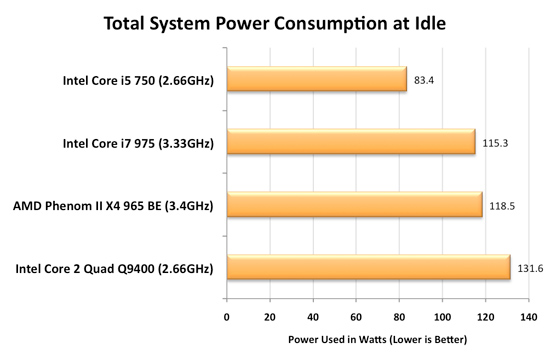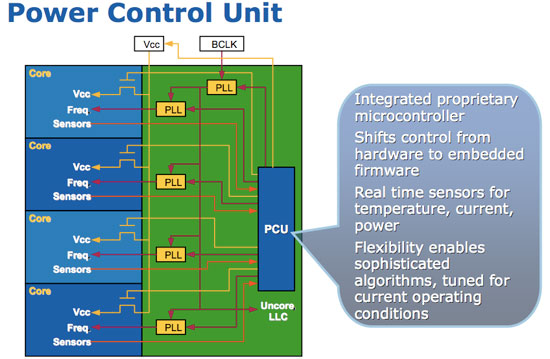Intel's Core i7 870 & i5 750, Lynnfield: Harder, Better, Faster Stronger
by Anand Lal Shimpi on September 8, 2009 12:00 AM EST- Posted in
- CPUs
Homework: How Turbo Mode Works
AMD and Intel both figured out the practical maximum power consumption of a desktop CPU. Intel actually discovered it first, through trial and error, in the Prescott days. At the high end that's around 130W, for the upper mainstream market that's 95W. That's why all high end CPUs ship with 120 - 140W TDPs.
Regardless of whether you have one, two, four, six or eight cores - the entire chip has to fit within that power envelope. A single core 95W chip gets to have a one core eating up all of that power budget. This is where we get very high clock speed single core CPUs from. A 95W dual core processor means that individually the cores have to use less than the single 95W processor, so tradeoffs are made: each core runs at a lower clock speed. A 95W quad core processor requires that each core uses less power than both a single or dual core 95W processor, resulting in more tradeoffs. Each core runs at a lower clock speed than the 95W dual core processor.
The diagram below helps illustrate this:
| Single Core | Dual Core | Quad Core | Hex Core | |
| TDP |  |  |  |  |
| Tradeoff |  |  |  |  |
The TDP is constant, you can't ramp power indefinitely - you eventually run into cooling and thermal density issues. The variables are core count and clock speed (at least today), if you increase one, you have to decrease the other.
Here's the problem: what happens if you're not using all four cores of the 95W quad core processor? You're only consuming a fraction of the 95W TDP because parts of the chip are idle, but your chip ends up being slower than a 95W dual core processor since its clocked lower. The consumer has to thus choose if they should buy a faster dual core or a slower quad core processor.
A smart processor would realize that its cores aren't frequency limited, just TDP limited. Furthermore, if half the chip is idle then the active cores could theoretically run faster.
That smart processor is Lynnfield.
Intel made a very important announcement when Nehalem launched last year. Everyone focused on cache sizes, performance or memory latency, but the most important part of Nehalem was far more subtle: the Power Gate Transistor.
Transistors are supposed to act as light switches - allowing current to flow when they're on, and stopping the flow when they're off. One side effect of constantly reducing transistor feature size and increasing performance is that current continues to flow even when the transistor is switched off. It's called leakage current, and when you've got a few hundred million transistors that are supposed to be off but are still using current, power efficiency suffers. You can reduce leakage current, but you also impact performance when doing so; the processes with the lowest leakage, can't scale as high in clock speed.
Using some clever materials engineering Intel developed a very low resistance, low leakage, transistor that can effectively drop any circuits behind it to near-zero power consumption; a true off switch. This is the Power Gate Transistor.

On a quad-core Phenom II, if two cores are idle, blocks of transistors are placed in the off-state but they still consume power thanks to leakage current. On any Nehalem processor, if two cores are idle, the Power Gate transistors that feed the cores their supply current are turned off and thus the two cores are almost completely turned off - with extremely low leakage current. This is why nothing can touch Nehalem's idle power:

Since Nehalem can effectively turn off idle cores, it can free up some of that precious TDP we were talking about above. The next step then makes perfect sense. After turning off idle cores, let's boost the speed of active cores until we hit our TDP limit.

On every single Nehalem (Lynnfield included) lies around 1 million transistors (about the complexity of a 486) whose sole task is managing power. It turns cores off, underclocks them and is generally charged with the task of making sure that power usage is kept to a minimum. Lynnfield's PCU (Power Control Unit) is largely the same as what was in Bloomfield. The architecture remains the same, although it has a higher sampling rate for monitoring the state of all of the cores and demands on them.
The PCU is responsible for turbo mode.










343 Comments
View All Comments
moronsworld - Saturday, September 26, 2009 - link
To all you morons that don't understand economics. amd gone = intel monopoly = intel processors overpriced. Plain and simple. Take an economy class or 2, you morons. AMD is a good company, just that Intel's processors are better at the moment. God too many morons in this world that are allowed to vote. We live in a society ruled by morons.TA152H - Tuesday, September 8, 2009 - link
Actually, you don't really know what you're talking about.On-die memory controllers are nothing new. The Nexgen 586 had it in the mid-90s. Intel just knew when to add it, and when not to. That's why the Core 2 blows AMD processors away, while being significantly smaller.
AMD instruction schedulers were behind Intel's Pentium Pro from 1995 until the Phenom II came out. It still doesn't have full memory disambiguation like Intel introduced with the Core 2, but at least the memory scheduling is now on par with the Pentium Pro. I'm not sure that something they like brought up though.
64-bit processing is also old hat, and really was just an extension of the 386 protected mode anyway, with a lot of Microsoft input.
The K8 wasn't really much of an architecture, it was a K7 with a memory controller, and a couple of extra stages for better IPC, that most idiots thought was for higher clock speeds. It was a failure, and was what put AMD in the situation where they are now. It was, generally, better than the Netburst, but then, is that such a high bar to get over? The problem was, they actually believed it was a good processor until the Core 2 relieved them of that misapprehension. The reality is, Intel's mobile chips were always better than the K8, but the damn fools made us buy the Pentium 4 for the desktop. To AMD's credit, at least they never made anything horrible like that, but, really, their primary claim to fame was based more on the terrible Intel design than a great processor of their own, and the fact Intel wouldn't let us use the mobile chips for desktops.
JonnyDough - Tuesday, September 8, 2009 - link
Please work on your English before replying to me in the future. Thanks.Aenslead - Tuesday, September 8, 2009 - link
So you *must* have perfect english to reply in these forums?Gosh, never saw that in the Terms and Conditions agreement when I created my account. So that means that anybody (or a nobody, like you) have a say on what other races and people from other countries that don't speak English as their first language, that LIKE READING and giving their opinion in a FREE MOFO OPEN FORUM, must do to post here?
You and your kind are pathetic.
JonnyDough - Tuesday, September 8, 2009 - link
I didn't say anything about having perfect English. You sir, are a troll. I just wanted his reply to be coherent. This is the ENGLISH version of DailyTech, there are other language versions. His post didn't even make sense, and yours was just trolling.ginbong - Wednesday, September 9, 2009 - link
I understood what he said, maybe you need to sharpen up your analytical skills and stop being a dlckhead on this hardware analysis website.Better yet, how about taking the money you have saved for your next PC upgrade and enrolling into Grade 1 again.
dastruch - Tuesday, September 8, 2009 - link
and you don't get it too... patheticjigglywiggly - Tuesday, September 8, 2009 - link
This is a hot cpu, except I want 6 cores + HT. 32nm... quads ahh yeah. I still don't like the i5, because I don't want two sockets on one brand at the same time. It just limits options, I am only looking at i7/i9, because I bought this qx6700 in 2006 for 1000$. It was a good purchase, because q6600s were a while away and they were 500$. I got my qx6700 to 3.85ghz, now it's at 3.5ghz stable. Curse you electromigration! Also curse you economy! I don't have enough money for a 6core+6HT 1000$ cpu again.JonnyDough - Tuesday, September 8, 2009 - link
*Laughs at the moron...Go buy a Ferrari and then wreck it and sell it for parts. That's essentially a larger scale version of what you did.
Lifted - Tuesday, September 8, 2009 - link
Huh? Buying a $1000 CPU is like wrecking a Ferrari?"Laughs at the moron"